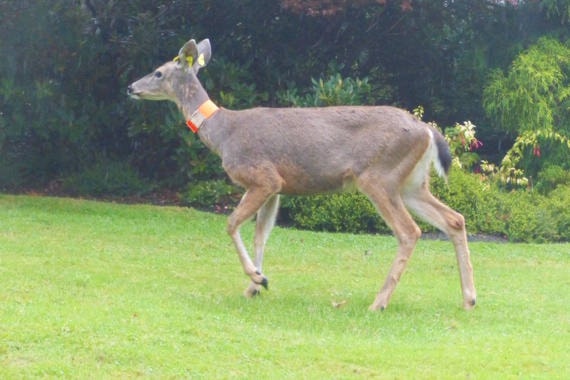Oak Bay does are decked out in colourful new accessories as part of this fall’s immuno-contraceptive campaign, designed to reduce the number of new deer born in the community.
Spearheaded by the Urban Wildlife Stewardship Society, orange-vested teams have successfully immuno-contracepted 55 deer in less than three weeks.
“From the research undertaken with the community’s help, we have found the deer where the 2018 data from cameras and satellite collars said we would: in the areas where there are the highest densities of deer, such as in the Uplands, around the golf courses, and some areas of South Oak Bay,” says Dr. Jason Fisher, lead scientist for the research project.
The field team, led by wildlife veterinarian Dr. Adam Hering and Dr. Fisher, used the same method of sedation as when the UWSS fitted 20 does with GPS collars in spring 2018.
Here’s how it works:
- First the deer are darted with a sedative; once that takes effect, they’re blindfolded to help keep them calm.
- Blood and fur samples are taken for the province, immuno-contraception is administered by injection, and matching small, colour-coded, numbered tags are applied to each ear, in addition to a smaller provincial tag. A lidocaine injection in each ear numbs them for several hours so the does don’t feel pain from the ear piercings.
- The doe then receives a reversal drug that has her back on her feet within minutes.
The colour-coded tags match a simple, coloured collar – not GPS collars but leather ones that simply help UWSS wildlife biologists individually identify each doe both on the camera array spread across Oak Bay, and when they’re looking for the does for their IC booster, Dr. Fisher explains.
The identification collars fit high on the doe’s neck, and more snugly than the GPS collars, minimizing chafing noticed from some of the GPS collars.
“While chafing generally isn’t a problem because the fur grows back, we’re always looking for ways to minimize the discomfort experienced by any animals that we handle,” says Dr. Hering.
With the first round of vaccinations close to being complete, the deer are now receiving a booster shot to maximize the efficacy of the immuno-contraceptive. The does don’t need to be sedated for the booster shot, allowing the second part of the process to move quickly.
The Oak Bay initiative is the first ever large-scale action research project for deer immuno-contraception. By demonstrating an effective, non-lethal and sustainable approach to reduce an urban deer population, this cutting-edge Oak Bay project will show the way for deer management in other communities, says Kristy Kilpatrick, UWSS president.
For more information on the UWSS immuno-contraceptive initiative, visit the FAQ page. If you have questions, or see a doe that is having an issue with her collar or ear, please email info@uwss.ca.
